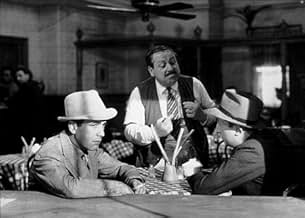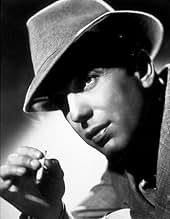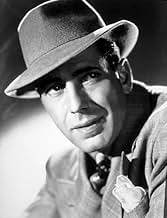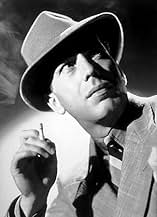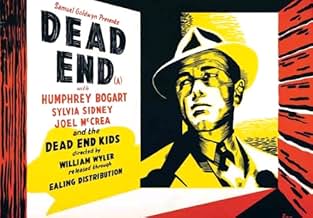IMDb RATING
7.2/10
9.3K
YOUR RATING
The lives of a young man, a young woman, a notorious gangster, and a group of street kids converge one day in a volatile New York City slum.The lives of a young man, a young woman, a notorious gangster, and a group of street kids converge one day in a volatile New York City slum.The lives of a young man, a young woman, a notorious gangster, and a group of street kids converge one day in a volatile New York City slum.
- Director
- Writers
- Stars
- Nominated for 4 Oscars
- 1 win & 4 nominations total
Leo Gorcey
- Spit
- (as Leo B. Gorcey)
- Director
- Writers
- All cast & crew
- Production, box office & more at IMDbPro
Featured reviews
Dead End the film adaption of Sidney Kingsley's play that ran for 687 performances during the 1935-1937 seasons, was a harbinger of what Alfred Hitchcock tried to do in such films as Rope and even more so in Rear Window. The whole story is told on one very complex set showing the stark contrast of the rich penthouse dwellers with the inhabitants of the nearby tenements and flats.
Building that set on stage and for the screen must have been one expensive proposition so it was a good thing Sidney Kingsley wrote a hit.
It may be one set, but the plot of the film involves three stories and how they interconnect. Story number one is about Joel McCrea, a former slum kid himself who still lives down there while he tries to get a job as an architect. He's involved with two women, rich socialite Wendy Barrie who lives in the penthouse and Sylvia Sidney who played more working class women than anyone else during the Thirties.
Sidney works as a seamstress in a garment factory and she's currently on strike and she's got a younger brother to support who causes her much grief. The younger brother is Billy Halop and Sidney worries about the gang he runs with, the kids who later became known as the Dead End kids, later East Side Kids, later Bowery Boys. Their a rough bunch and they get a visit from a celebrity of sorts.
Which leads us to the third track in the person of Humphrey Bogart who grew up on this same block and is now a wanted fugitive of the John Dillinger variety. The kids and McCrea recognize him, the kids worship him and McCrea is willing to give him a pass for now, he's no rat. All their stories mix in this plot which does hold the interest through out the film.
Besides the Dead End Kids who didn't all play the same roles you see them play on the screen only one other player came over from Broadway for the screen version. Marjorie Main who we usually know as the rambunctious and brassy Ma Kettle plays a very serious part indeed as Humphrey Bogart's mother. You'll not forget her as she rejects her hoodlum son both the anger and sorrow she expresses, it is haunting.
Bogart got another jolt in his trip down memory lane in the slum in the person of Claire Trevor. She's usually a good time girl with a heart of gold. Her heart may be golden in Dead End, but she's a woman who's seen the seamy side of life as a prostitute. Very few prostitutes were portrayed as such during the days of The Code so in that sense Dead End was quite daring.
The film is firmly set in the Depression Thirties. That same area where in certain shots you can see the Queensborough Bridge in the near distance is some of the richest real estate on earth now. Those same buildings that are portrayed as slums now rent to yuppies at obscene figures if in fact they survived.
Though Dead End is a dated piece of work, it does offer a great glimpse into urban life for the rich and poor. This is one of Samuel Goldwyn's best productions and William Wyler gets uniformly fine performances from his talented cast of players.
Building that set on stage and for the screen must have been one expensive proposition so it was a good thing Sidney Kingsley wrote a hit.
It may be one set, but the plot of the film involves three stories and how they interconnect. Story number one is about Joel McCrea, a former slum kid himself who still lives down there while he tries to get a job as an architect. He's involved with two women, rich socialite Wendy Barrie who lives in the penthouse and Sylvia Sidney who played more working class women than anyone else during the Thirties.
Sidney works as a seamstress in a garment factory and she's currently on strike and she's got a younger brother to support who causes her much grief. The younger brother is Billy Halop and Sidney worries about the gang he runs with, the kids who later became known as the Dead End kids, later East Side Kids, later Bowery Boys. Their a rough bunch and they get a visit from a celebrity of sorts.
Which leads us to the third track in the person of Humphrey Bogart who grew up on this same block and is now a wanted fugitive of the John Dillinger variety. The kids and McCrea recognize him, the kids worship him and McCrea is willing to give him a pass for now, he's no rat. All their stories mix in this plot which does hold the interest through out the film.
Besides the Dead End Kids who didn't all play the same roles you see them play on the screen only one other player came over from Broadway for the screen version. Marjorie Main who we usually know as the rambunctious and brassy Ma Kettle plays a very serious part indeed as Humphrey Bogart's mother. You'll not forget her as she rejects her hoodlum son both the anger and sorrow she expresses, it is haunting.
Bogart got another jolt in his trip down memory lane in the slum in the person of Claire Trevor. She's usually a good time girl with a heart of gold. Her heart may be golden in Dead End, but she's a woman who's seen the seamy side of life as a prostitute. Very few prostitutes were portrayed as such during the days of The Code so in that sense Dead End was quite daring.
The film is firmly set in the Depression Thirties. That same area where in certain shots you can see the Queensborough Bridge in the near distance is some of the richest real estate on earth now. Those same buildings that are portrayed as slums now rent to yuppies at obscene figures if in fact they survived.
Though Dead End is a dated piece of work, it does offer a great glimpse into urban life for the rich and poor. This is one of Samuel Goldwyn's best productions and William Wyler gets uniformly fine performances from his talented cast of players.
The main credit of "Dead End" lies in the stunning visual beauties. The studio reproduction of a New York slum is really magnificent, worth of other major achievements of the same kind, like, say, the set of "Rear Window". A true joy for the eyes. The work of the camera and William Wyler's direction are outstanding, as well. And, of course, the job of the cast is great. Bogart, still in the role of the villain, McCrea and Sylvia Sidney are excellent, and save their rather straightforward characters and lines. In my opinion, the best one is Claire Trevor, in the small part of the lost girl. I normally dislike kids on the screen, but I must concede that here they give great performances, playing the gang of street-boys.
The story is conventional, with a noble message, but few and predictable twists. The script is often clumsy and preachy. Luckily enough, the director gives a quick pace to the narration and inserts a number of humoristic touches. There's a main flaw in the plot: I think that, even in the States of the 1930s, a common citizen couldn't freely shoot a gangster.
Anyway, I've found in the screen-play an interesting and modern theme, namely the psychological ambiguity of some characters, whom even the all-knowing viewer cannot fully understand. For instance, Claire Trevor is apparently the cliche disgraced girl, the innocent victim of poverty, lack of opportunities, social injustice. To end as a prostitute is her unavoidable doom... But, when her former boy-friend Bogie gives some money to help her, she makes the horribly vulgar request of "twenty more bucks"... with a grimace worth of a hardened prostitute (great stuff by Trevor!). So we see that, after all, perhaps that girl is not so innocent as she pretends to be... And what about Drina's brother, the leader of the street-boys? The audience is perfectly aware that, in spite of his whining, weeping self-apologies (when he's in dire straits), the boy is a REAL criminal. We see that he deliberately harms people, steals, brutally thrashes the rich kid, wants to slash his gang-mate. And he just mocks his affectionate sister and his friend McCrea when, in tears, he cries that he's good, that he didn't intend to harm, and all that. So, are we supposed to feel sympathy for this hideous boy? Interesting ambiguity, which creates a fine artistic effect... perhaps beyond the actual intentions of the writer Lillian Hellman.
All in all, we may forgive the defects of the movie. it is worth seeing "Dead End", enjoying the beauty of the set and the work of director and actors.
The story is conventional, with a noble message, but few and predictable twists. The script is often clumsy and preachy. Luckily enough, the director gives a quick pace to the narration and inserts a number of humoristic touches. There's a main flaw in the plot: I think that, even in the States of the 1930s, a common citizen couldn't freely shoot a gangster.
Anyway, I've found in the screen-play an interesting and modern theme, namely the psychological ambiguity of some characters, whom even the all-knowing viewer cannot fully understand. For instance, Claire Trevor is apparently the cliche disgraced girl, the innocent victim of poverty, lack of opportunities, social injustice. To end as a prostitute is her unavoidable doom... But, when her former boy-friend Bogie gives some money to help her, she makes the horribly vulgar request of "twenty more bucks"... with a grimace worth of a hardened prostitute (great stuff by Trevor!). So we see that, after all, perhaps that girl is not so innocent as she pretends to be... And what about Drina's brother, the leader of the street-boys? The audience is perfectly aware that, in spite of his whining, weeping self-apologies (when he's in dire straits), the boy is a REAL criminal. We see that he deliberately harms people, steals, brutally thrashes the rich kid, wants to slash his gang-mate. And he just mocks his affectionate sister and his friend McCrea when, in tears, he cries that he's good, that he didn't intend to harm, and all that. So, are we supposed to feel sympathy for this hideous boy? Interesting ambiguity, which creates a fine artistic effect... perhaps beyond the actual intentions of the writer Lillian Hellman.
All in all, we may forgive the defects of the movie. it is worth seeing "Dead End", enjoying the beauty of the set and the work of director and actors.
Brilliant adaptation of a hit Broadway play about life in the slums of New York during the Great Depression. A gangster on the run from the law returns to the neighborhood he grew up in to plot his next move. Add to that a little romance and a gang of street kids getting into trouble and you've got a first-rate Warner Bros. urban drama picture (only this wasn't made by Warners). Humphrey Bogart plays the gangster character 'Baby Face' Martin. In some ways it was a very familiar role to many others he'd played up to this point, but this one was a bit more layered and gave him a chance to flex his acting muscles some. Solid turns from Joel McCrea, Wendy Barrie, Claire Trevor, and Marjorie Main. Allen Jenkins is always fun to watch. Next to Bogart, I'd have to say the standout is the lovely Sylvia Sidney, one of my favorite actresses from this period. She had some of the most expressive eyes in the business.
Among other things, the film's notable for being the first screen appearance of the Dead End Kids, who would go on to appear in several WB gangster pictures (in basically the same roles as this) before starring in a few series of their own under different names, my favorite of which was the Bowery Boys. It's interesting to see them here looking and acting much more like roughneck teenagers than later where they were clearly adults behaving like overgrown kids. Directed by William Wyler, this is a "message movie" from a time when those types of movies actually felt earnest and not phony or preachy. Yes it's pretty much a filmed stage play, which was very common in the 1930s, but the great cast, excellent sets, and Gregg Toland's beautiful photography goes a long way to bringing it all to life. Not one you'll want to pass up if you're a fan of the stars or the period.
Among other things, the film's notable for being the first screen appearance of the Dead End Kids, who would go on to appear in several WB gangster pictures (in basically the same roles as this) before starring in a few series of their own under different names, my favorite of which was the Bowery Boys. It's interesting to see them here looking and acting much more like roughneck teenagers than later where they were clearly adults behaving like overgrown kids. Directed by William Wyler, this is a "message movie" from a time when those types of movies actually felt earnest and not phony or preachy. Yes it's pretty much a filmed stage play, which was very common in the 1930s, but the great cast, excellent sets, and Gregg Toland's beautiful photography goes a long way to bringing it all to life. Not one you'll want to pass up if you're a fan of the stars or the period.
In "Dead End" the nominal stars are Sylvia Sidney and Joel McCrea but it is the supporting players that steal the picture. Great performances are turned in by the Dead End Kids (Billy Halop, Huntz Hall, Bobby Jordan, Leo Gorcey, Bernard Punsley), Humphrey Bogart, Claire Trevor and Marjorie Main. It also benefits greatly from the direction of William Wyler who keeps the story moving and makes the characters interesting.
"Dead End" was originally produced on the Broadway stage. The Dead End Kids re-enact their Broadway roles. The story takes place on the banks of the East River in New York where posh apartment buildings co-habit the neighborhood with the tenement slums. The plot centers on the activities of the people of the neighborhood one summer's day.
Dave Connell (McCrea) is a struggling architect looking for his big break. Drina (Sidney) is a struggling shop clerk who is involved in a labor dispute and hopes one day to be able to leave the neighborhood. Gangster "Baby Face" Martin (Bogart) returns to his childhood haunts hoping to see his mother (Main) and hook up with his old girlfriend Francey (Trevor). Hanging around the wharf are a group of teenage toughs (The Dead End Kids) one of whom, Tommy (Halop) is the brother of Drina.
The boys taunt rich kid Philip Griswald (Charles Peck) and lure him down to the street. There he is beaten up by the boys. His father (Minor Watson) is highly influential man who insists on justice for his son. One of the boys, "Spit" squeals on his pal and Tommy is arrested after stabbing Mr. Griswald in the hand.
Meanwhile Martin goes to see his mother and is shocked when she slaps him and calls him a murderer. Martin's pal "Hunk" (Allen Jenkins) locates Francey and arranges for her to come meet "Baby Face". Martin is doubly shocked when he learns that his former love has pursued a career on the streets.
During an altercation with Dave over the influencing of the boys, Martin stabs him and throws him into the river, leaving him for dead. Martin then hatches a plot to kidnap the rich kid Philip Griswald. But Dave returns, confronts Martin and..............
This film is arguably Bogey's best film of the 1930s. Oddly enough, it was made on loan out to Samuel Goldwyn. His expressions of surprise and disgust after meeting with his mother and Francey are a treasure to watch. Trevor's performance, however brief, was moving enough to garner her a best supporting actress Oscar nomination. Marjorie Main also only appears briefly but evokes great sympathy in her role as the tragic Mrs. Martin.
The Dead End Kids to a man turn in what are the best performances in the film. They would go on to appear in a series of Warner Bros films in the next two years before moving into several "B" series in the 40s and 50s. Also, look for Ward Bond as the doorman to the rich apartment building and Don "Red" Barry as an abalones doctor.
An excellent film.
"Dead End" was originally produced on the Broadway stage. The Dead End Kids re-enact their Broadway roles. The story takes place on the banks of the East River in New York where posh apartment buildings co-habit the neighborhood with the tenement slums. The plot centers on the activities of the people of the neighborhood one summer's day.
Dave Connell (McCrea) is a struggling architect looking for his big break. Drina (Sidney) is a struggling shop clerk who is involved in a labor dispute and hopes one day to be able to leave the neighborhood. Gangster "Baby Face" Martin (Bogart) returns to his childhood haunts hoping to see his mother (Main) and hook up with his old girlfriend Francey (Trevor). Hanging around the wharf are a group of teenage toughs (The Dead End Kids) one of whom, Tommy (Halop) is the brother of Drina.
The boys taunt rich kid Philip Griswald (Charles Peck) and lure him down to the street. There he is beaten up by the boys. His father (Minor Watson) is highly influential man who insists on justice for his son. One of the boys, "Spit" squeals on his pal and Tommy is arrested after stabbing Mr. Griswald in the hand.
Meanwhile Martin goes to see his mother and is shocked when she slaps him and calls him a murderer. Martin's pal "Hunk" (Allen Jenkins) locates Francey and arranges for her to come meet "Baby Face". Martin is doubly shocked when he learns that his former love has pursued a career on the streets.
During an altercation with Dave over the influencing of the boys, Martin stabs him and throws him into the river, leaving him for dead. Martin then hatches a plot to kidnap the rich kid Philip Griswald. But Dave returns, confronts Martin and..............
This film is arguably Bogey's best film of the 1930s. Oddly enough, it was made on loan out to Samuel Goldwyn. His expressions of surprise and disgust after meeting with his mother and Francey are a treasure to watch. Trevor's performance, however brief, was moving enough to garner her a best supporting actress Oscar nomination. Marjorie Main also only appears briefly but evokes great sympathy in her role as the tragic Mrs. Martin.
The Dead End Kids to a man turn in what are the best performances in the film. They would go on to appear in a series of Warner Bros films in the next two years before moving into several "B" series in the 40s and 50s. Also, look for Ward Bond as the doorman to the rich apartment building and Don "Red" Barry as an abalones doctor.
An excellent film.
i'm a huge Bogey fan, so naturally i'll watch anything with his name in the credits. however, i was not prepared for "dead end." this is one of the most brilliant films i've ever seen and i can't understand why the eberts and roepers and maltins never talk about this one. it begins as a familiar story, rich vs. poor along the east river. a gang of kids hang around outside the ritzy, new apartments in the neighborhood. tommy, it's leader and his "friends" notice a boy who has been earning pocket money as a babysitter. when tommy steals his money, a fight breaks out. off in the distance, two men in silk suits watch the fight. tommy's sister drina breaks up the fight. drina is a working class woman on strike, trying to earn the money she deserves. Dave is her on-again, off-again love interest who has done everything in the book to try to rise out of poverty, but still can't get ahead. Dave has been seeing Kay, a young woman torn between a future with a man she thinks she may love (Dave) and the comforts of wealth. we find out the two men in silk suits are gangsters, one being the famous killer, baby face martin, who has returned to his home to see his mother and old girlfriend. he is rejected by his mother, who is disgusted by his profession and track record and his girlfriend, who has become a common prostitute. their are a million intertwining story lines that add up to one incredible climax, but essentially this film is about the cycle of poverty and class issues. the performances are terrific. Sylvia Sidney (not a big name today, but a damn good actress) and Joel mccrea are perfection as the films heroes. Bogart is unforgettable. this is one of the dozens of gangsters he played, but i would rate this performances as high as duke manatee in petrified forest. he's tough and street smart, but with each disappointment we see evidence of his emotions leaking out. the gang of kids remind me of the jets in west side story- they don't like anyone, not even each other half the time. look for Marjorie main (ma kettle before she was ma kettle!) in a touching, but heartbreaking scene as Bogey's frail, aging mother and Claire Trevor (another fine, forgotten actress) as Bogey's sweetheart turned greedy streetwalker. the best thing about this film is they way each character believes he or she can overcome the way of life he or she seems fated to live with. each character tries desperately and fails. this is the way real people are. there's no Hollywood, sugar-coatedness about any of it. no over-dramatic music or made-for-the-previews lines. it's grossly realistic. this film would be on my top 50 list, maybe even my top 25. it's that good.
Did you know
- TriviaWilliam Wyler gave Claire Trevor an old purse and broken high heel shoes. He had her minimize her make-up and ordered her not to comb her hair when she got up in the morning. He wanted her to look like the downtrodden character she was playing.
- GoofsBaby Face Martin suddenly appears from nowhere and is leaning against a railing as the boys are fighting.
- Crazy creditsOpening credits prologue: Every street in New York ends in a river. For many years the dirty banks of the East River were lined with the tenements of the poor. Then the rich, discovering that the river traffic was picturesque, moved their houses eastward. And now the terraces of these great apartment houses look down into the windows of the tenement poor.
- ConnectionsFeatured in AFI Life Achievement Award: A Tribute to William Wyler (1976)
- SoundtracksBoo-Hoo
(1937) (uncredited)
Music by Carmen Lombardo and John Jacob Loeb
Lyrics by Edward Heyman
Played at the upstairs party and sung by Huntz Hall in the street
- How long is Dead End?Powered by Alexa
Details
Box office
- Budget
- $300,000 (estimated)
- Runtime1 hour 33 minutes
- Color
- Aspect ratio
- 1.37 : 1
Contribute to this page
Suggest an edit or add missing content



